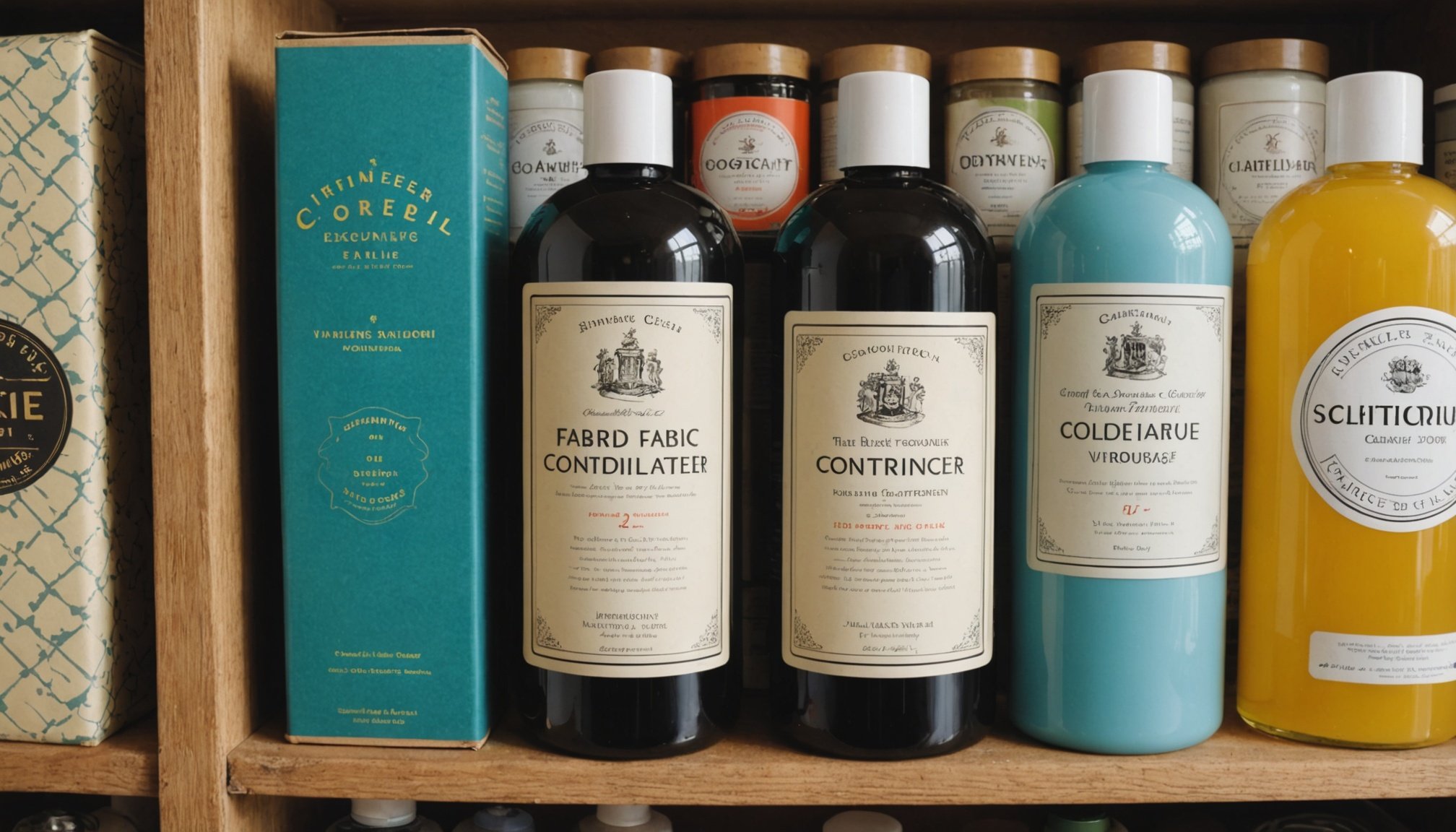Understanding Fabric Conditioners
Fabric conditioners, often seen as a staple in fabric care, come in various forms tailored to meet specific needs. The types of fabric conditioners range from liquid to sheet and even natural alternatives. Each has unique properties that cater to different fabric conditioner types. For vintage garments, selecting the right kind is crucial to maintain their delicate nature.
The compatibility of fabric with the chosen conditioner is vital in preserving vintage garments. Using an incompatible type can lead to potential damage, affecting the fabric’s longevity. For instance, liquid conditioners are well-suited for softening, while natural alternatives might be better for those sensitive to fragrances and additives.
Have you seen this : Ultimate Guide to Choosing the Best Waterproof Eyeliner for London’s Rainy Days: Achieve All-Day Glam
The effect of various conditioners on fabric longevity is significant. By enhancing softness, reducing static, and providing a layer of protection, conditioners play a pivotal role in prolonging the life of vintage clothing. However, be mindful of the impact fragrances and additives can have on sensitive materials. Proper selection and application can prevent deterioration, enabling the preservation of original appearance and texture. Pay close attention to expert recommendations and always verify the compatibility with vintage pieces to ensure their safety.
Recommended Fabric Conditioners for Vintage Wardrobes
When selecting fabric conditioners for vintage garments, choosing suitable products is essential for maintaining their condition. Vintage fabrics often require conditioners that provide gentle care while ensuring protection against deterioration.
This might interest you : Discovering Your Ideal Heel Height: The Ultimate UK Guide to Stylish Comfort
One key consideration is finding fabric conditioners that are free from harsh chemicals or heavy fragrances. Such additives can damage delicate fibres, making them unsuitable for antique garments. Natural and fragrance-free conditioners are often recommended, as they offer softness without the risk of causing irritation or damage. They help enhance vintage fabric protection by preserving the original texture and appearance.
Products like Woolite Delicates and The Laundress Fabric Conditioner have been praised by users for their gentleness and effectiveness. These are frequently cited in expert fabric care recommendations, providing reliable softening while being safe for vintage materials.
Among the community of vintage clothing enthusiasts, feedback highlights how using the right conditioner has successfully maintained fabric care and extended garment life. It is beneficial to consult user testimonials and expert opinions on preferred brands, allowing you to make a well-informed decision in selecting a conditioner that best meets the specific needs of your vintage wardrobe while ensuring long-lasting preservation.
Risks Associated with Fabric Conditioners
When it comes to vintage garment care, using the right fabric conditioner is critical to avoid potential damage. Fabric care risks are often linked to the use of inappropriate conditioners that may contain harsh chemicals or fragrances. These can be detrimental to delicate fibres, leading to degradation over time. Potential damage such as fading, loss of softness, and weakening of fabric structure can occur if conditioners are not selected with compatibility in mind.
The use of fragrances and additives in fabric conditioners also poses risks to vintage fabric safety. Sensitive materials may react adversely to these substances, causing irritation or even lasting harm. To illustrate the consequences, several case studies reveal significant damage, such as discolouration and weakening of threads, resulting from improper use of conditioners. The symptoms were often traced back to incompatibility with the fabric’s material or excessive application.
Understanding the delicate balance required for preserving vintage garments’ integrity underscores the need for careful selection and application. Following expert guidance on vintage fabric safety, and avoiding harmful additives, helps mitigate these risks, ensuring the longevity and preservation of cherished vintage pieces.
Application Methods for Fabric Conditioners
To maintain the integrity of vintage garment care, adhering to the right application techniques is vital. A key first step is understanding the material specificity. Application techniques differ based on fabric types, such as cotton or silk, ensuring conditioners are evenly distributed and work effectively.
Start with a conditioning process tailored to the garment’s fragility. Generally, use recommended dilution ratios. For instance, a lighter mix for silk may consist of a teaspoon of conditioner to two cups of water, while sturdier fabrics may handle slightly more concentrate. Gentle hand washing is often encouraged to minimise stress on delicate threads and fibres.
Thoroughly rinse vintage items after application. This step prevents residue build-up, which can compromise the fabric over time. A gentle rinse cycle in a washing machine might suffice; however, manual rinsing often allows for greater control and caution in sensitive cases.
Paying attention to the vintage garment care process will ensure longevity and maintenance of original appearances. Experts emphasise methodical application and rinsing, key for enhancing texture and fabric protection. Following these strategic methods significantly reduces potential risks associated with conditioners, ensuring your vintage wardrobe remains preserved and cherished.
Expert Insights and Case Studies
In the realm of fabric conditioning, expert opinions provide pivotal insights into its implications for vintage clothing. Textile conservation specialists highlight that proper conditioning practices can significantly extend the life of vintage garments. For instance, interviews with experts have underscored the importance of fabric compatibility and careful selection of fabric conditioner types, particularly for delicate vintage items.
Case studies offer practical examples, illustrating the benefits gained from expert-recommended methods. These studies often focus on vintage garment care, showcasing successful preservation methods that enhanced vintage fabric protection and maintained the original appearance. One documented case demonstrated how using a conditioner compatible with silk fabrics prevented deterioration and enhanced texture, resulting in less static and maintained softness over time.
Experts also discuss long-term benefits, noting that maintaining a garment’s original look involves more than just occasional conditioning. Regular and informed use of the correct type can prevent common fabric care risks, such as fading or fibre weakening. By following guidelines provided by fabric conservation experts and relying on trustworthy case studies, individuals can ensure their vintage wardrobe remains in premium condition for years to come, preserving not only its aesthetic but its historical value as well.
Tips for Selecting the Right Fabric Conditioner
Choosing the ideal fabric conditioner for your vintage clothing is crucial for ensuring safe and effective maintenance. This starts with understanding a few key factors to preserve your treasured garments.
Key Considerations:
- Fabric Compatibility: Ensure the conditioner’s ingredients are suitable for your specific vintage materials. Some conditioners are explicitly designed for delicate fabrics.
- Absence of Harsh Chemicals: Opt for products without strong acids or solvents that could weaken fibres over time, prioritising those marked as natural or organic.
- Fragrance Sensitivity: For sensitive or aged fabrics, choose fragrance-free or lightly scented options to avoid potential irritants.
Recommended Products:
Different vintage fabrics may need various conditioners:
- For silk, a mild solution is preferable to avoid residue or fabric stiffness.
- Cotton and linen might benefit from softeners offering enhanced moisture retention.
- Always cross-reference with expert recommendations for specific garment blends.
Further Insights:
Fabric care experts stress that prior user testimonials and reviews play a significant role in the decision process. Evaluating community feedback alongside expert advice helps in selecting the safest and most compatible conditioner for your vintage collection. Balancing these elements ensures your garments are preserved meticulously.
Understanding Fabric Conditioners
Fabric conditioners are available in a diverse range of formulations designed for various applications in vintage garment care. Knowing the numerous fabric conditioner types is crucial for maintaining vintage clothing’s integrity. Liquid conditioners are often favoured for their ability to penetrate textiles and deliver consistent enhancement of texture and softness. Sheets, on the other hand, are popular for their convenience, primarily used in tumbling dryers to combat static cling.
Natural conditioners offer a fragrant-free choice, especially beneficial for those sensitive to synthetic additives. Materials like wool and silk, typical in vintage collections, require conditioners with particularly gentle preservation methods to avoid fibre damage. Using compatible products ensures these garments retain their original charm and resilience.
Ignoring compatibility between the fabric conditioner type and the vintage fabric could risk unintended wear, diminishing aesthetic and structural attributes over time. Appropriate conditioning contributes to extending the garment’s longevity, maintaining its original feel and appearance. This is vital as non-compatible treatments can introduce fabric care risks like discolouration or texture loss. The proper selection can prevent these outcomes, ensuring a lasting vintage collection that’s as visually appealing as it is tactilely delightful.











